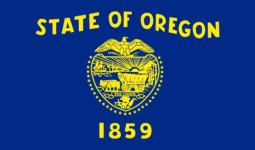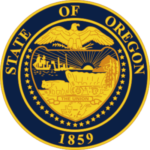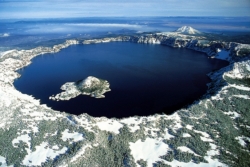Oregon
Oregon is a state in the Pacific Northwest of the United States. It is bordered on its west by the Pacific Ocean, north by Washington, south by California, east by Idaho, and southeast by Nevada.
- ABBREVIATION: OR
- NICKNAME: The Beaver State
- POPULATION: 3,899,353 (2012 est.)
- CAPITAL: Salem
- STATE BIRD: Western Meadowlark
- STATE FLOWER: Oregon Grape
- AREA: 98,381 sq. mi.
- TIME ZONE: Most of state: Pacific – most of Malheur County: Mountain
- ENTERED UNION: Feb. 14, 1859
- ALTITUDE: High, 11,249 ft. Mount Hood
- CLIMATE: Cold summers, mild winters, heavy rain along the coast and in Willamette Valley. Hot summers, cold winters in drier east.


Since the first pioneers pushed into the territory in the 1830’s, most Oregonians have settled in the Willamette Valley, a fertile trough bounded by the wide Columbia River, the coast and Cascade Ranges. To the northwest lies Portland, a major inland port which exercises commercial sway over the state’s long-standing industries; fruit, vegetable, and fish canning, lumber, pulp, and paper production.
Since the establishment of the state’s first sawmill in 1832, the life of Oregon has been intertwined with its great forests of Douglas Fir and Western Pine. Forests cover more than 30 million of Oregon’s 62 million acres – nearly half of the state’s landmass. As the number one lumber producer in the U.S., Oregon accounts for 18% of total U.S. softwood lumber production. Strict forest laws assure trees are planted and growing to replace timber harvested, thus, there has been almost no net loss in Oregon’s forest land since man arrived in the ‘Beaver’ State.

For land hungry pioneers in the 1840’s, the Oregon Trail was the main route to the Pacific Coast after Dr. Elijah White’s emigrant train traversed it in 1842. The Trail, winding 2,000 miles from Independence, Missouri, partly paralleled the path of Lewis and Clark, the first to prove that the northwest coast, which had been explored by the sea, could be reached overland. Use of the trail declined as the first transcontinental railroad was completed in 1869, thus making the trip west safer, cheaper, and faster.
FUN FACTS:
- Oregon takes its nickname from the abundant beaver that gave rise to a thriving fur trade in the early1800s.
- The U.S. Department of Energy’s Bonneville Power Administration, headquartered in Portland, provides about 45 percent (2001 est.) of the electricity used in the Pacific Northwest. Most of this power comes from 31 hydroelectric plants along the Columbia River.
- During World War II, Japan tried unsuccessfully to start huge fires along the Oregon coast by launching fire bombs.
- Oregon’s state flag pictures a beaver on its reverse side. It is the only state flag to carry two separate designs.
- Crater Lake is the deepest lake in the United States. It was formed more than 6,500 years ago. Its crystal-blue waters are world renowned.
- Eugene was the first city to have one-way streets.
